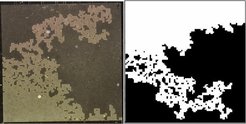Drying in microfluidic cells as a model granular material
We study the drying of porous granular materials on a microscopic scale in order to better understand drying mechanisms on the macroscopic scale. We aim to validate a 2D pore-scale model by experimental observations. The long-term goal is that of extending such class of models to real phenomena like water exchange between soil and atmosphere, invasion percolation and CO2 sequestration. To model a granular material we use microfluidic cells made of an array of round pillars, which represent the soil grains. The cells are open at one end to allow evaporation. We introduce different degrees of heterogeneity by changing the size and positions of the particles, as would be the case in a real, randomly packed, granular material. This heterogeneity can be random or vary over a given correlation length.
We flood the cells with a wetting volatile fluid and observe them as they dry. After an initial phase where evaporation happens mainly at the surface, we see the formation of several isolated clusters of fluid which evolve further in time. In order to characterize the resulting patterns, we use three Minkowski measures. These give us information on roughness of the leading front, connectivity of the dry area and saturation of the sample. Microfluidic experiments are coupled with simulations in order to validate our pore-scale model.

